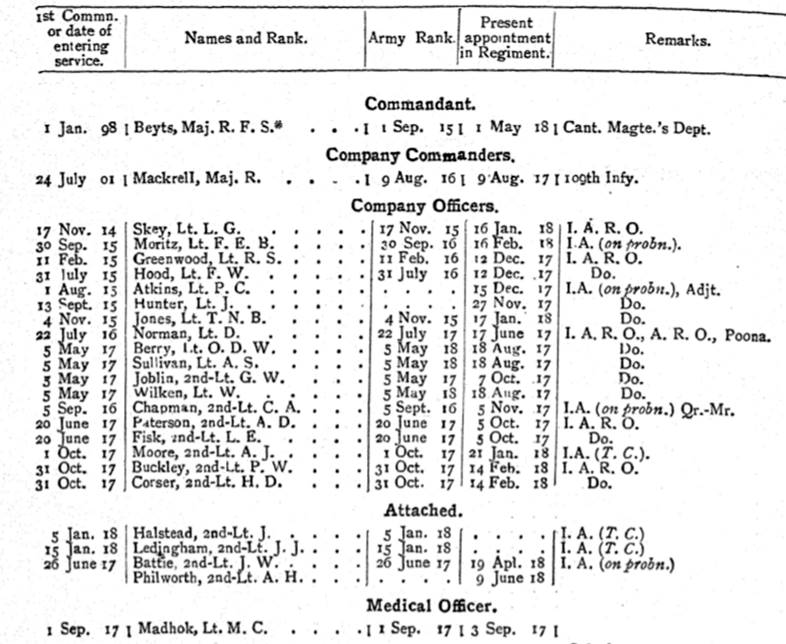This article on the 71st Punjabis will help you research this war-raised Indian infantry regiment and those who served with it during the First World War. I have written a series of guides in addition to this article to help you research a soldier who served in the Indian Army:
The 71st Punjabis in the First World War
Lineage: The 71st Punjabis was formed at Montgomery, now Sahiwal in Pakistan on 9 June 1917 and was amalgamated with the 111th Mahars at Aden, now part of Yemen in early 1922. After amalgamation, the new regiment was known as the 71-111th Infantry and was disbanded at some point between July and November 1922.
Class Composition of the Regiment in 1918: 4 Companies of Punjabi Christians.
The 71st Punjabis was a war raised regiment formed at Montgomery, present-day Sahiwal in Pakistan, on 9 June 1917. The 71st Punjabis was recruited solely from Punjabi Christians, making it the only Christian regiment in the Indian Army. Christians were recruited prior to the outbreak of war but in small numbers and typically into south Indian regiments (especially as musicians) and the Sappers and Miners. However, recruiting difficulties during the war meant that the Indian Army opened up its recruiting to new groups and ‘non-martial races‘. The 71st Punjabis initially served with the 44th (Ferozepore) Brigade of the 16th Indian Division and was stationed at Ferozepore. This Division remained in India for the duration of the war. In early 1918, a detachment of the 71st Punjabis served with the Marri Field Force and I have put a link to an article below. In May 1918, the 71st Punjabis left India for Bushire, Persia, now Iran where it probably served on the lines of communication.
The extracts below were taken from the confidential report of the 71st Punjabis’ Depot which was dated 24 January 1919. A common problem during the war was finding good quality Indian officers for newly recruited groups and this is borne out in the report.
The trouble was how to cope with an abnormal number of men and a totally inadequate and untrained staff left in charge of young and inexperienced officers. The Indian Officers have been most disappointing. The unit proceeded on Field Service and left the depot quite inadequately staffed and the accounts in chaos.
Brigadier-General Ernest Douglas Money C.I.E., D.S.O., Brigadier-General, Indian Depots.
This depot has been very heavily handicapped throughout its existence, but is now beginning to find its feet. There is still room for a great deal of improvement in drill and manoeuvre. Musketry for the reasons given in Parts I and II is very behindhand. Signalling has also been neglected.
But considerable improvement in discipline, training, turnout and interior economy has been effected during the last two months and if this is maintained the depot will shortly be able to compare much more favourably with others than before. I concur in the opinion of the Brigadier-General, Indian Depots that better selection of Indian Officers and Non-Commissioned Officers is most needed, and I look to the missionaries to help to provide better material for the purpose.
Major-General Francis John Fowler. C.B., D.S.O., Commanding Karachi Brigade.
Confidential review reports on Indian Army units, depots, British officers, etc. for 1918-1919: IOR/L/MIL/7/17030
The 71st Punjabis continued to serve in Persia after the war and many men qualified for the General Service Medal with South Persia clasp. Fortunately, there are over 250 medal index cards for this medal which have been digitized by the National Archives. The extract below was taken from the July 1919 Indian Army List and recorded the British officers serving with the Regiment. The Indian Army List is a very useful resource to research both regiments and officers and I have created a page to help you with its jargon: Indian Army Abbreviations and Acronyms.
Returning to India early in 1921, the Regiment was stationed at Agra where its Depot had been while it was in Persia. By August, the Regiment had moved to Dargai and Chakdara and by the end of the year was stationed at Nowshera. In early 1922, the 71st Punjabis was moved to Aden in what is now Yemen where it was amalgamated with the 111th Maharas to form the 71-111th Infantry. Returning to India later in the year, the newly formed Regiment was disbanded at some point between July and November 1922.
War Diaries for the 71st Punjabis
A war diary was written by an officer of a unit and recorded its location and activities. Unfortunately, there are no war diaries for the 71st Punjabis.
Further Sources for the 71st Punjabis
An excellent resource for the 71st Punjabis is its Confidential Reports held at the British Library: Confidential Reports on Regiments etc. These reports also contain the annual reports for the British officers serving with the 71st Punjabis. The Indian Army List will contain information regarding the British and Indian officers who served with the Regiment. The surviving Medal Index Cards for the General Service Medal can be viewed either on Ancestry or the National Archives website. I would recommend viewing them on Ancestry as they are currently available to view for free once you sign up. An article about the Marri Field Force can be read here: Fighting the Marris and the Khetrans by Harry Fecitt. This article looks at the Marri Field Force in which a detachment of the 71st Punjabis served.

